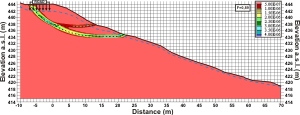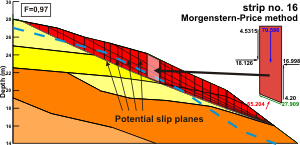Main Page | Knowledge base | Geotechnics | Stability calculations
STABILITY CALCULATIONS
There are many ways to calculate stability for landslides, slopes, but also for anthropogenic works such as road embankments, railways and other types. Nowadays, these calculations are done by specialized computer programs that use different algorithms in their calculations. The vast majority of them analyze the balance of forces in a given computational model. FoS (Factor of Safety) is the ratio of the generalized sum of friction and cohesion forces of the material and forces derived from the geotechnical protection of the slope (anchors, gabions, etc.), to the sum of generalized force loads, caused by gravity, filtration, static and dynamic loads.
The solution of this equation most often leads to finding the actual or potential slip surface, and the choice of a suitable computational method to evaluate the stability of the slope depends on its predicted form of deformation. When analyzing stability of rocks or soil slope, all possible elements of the landslide process should be taken into account.
When selecting a calculation method, it is recommended to consider:
- layering in the ground,
- occurrence and inclination of discontinuity,
- filtration and distribution of water pressure in the slope (taking into account the water),
- short and long-term stability,
- deformation of slope from creeping.

Computational model with boundary conditions for slope stability analysis with asphalt road
When analyzing a particular case, the calculation programs identify the slip surface group, whereby the safety factor for the most unfavorable is calculated. By using forces equilibrium methods, it’s assumed:
- flat stress – deformation state – two-dimensional character of the computational model (geotechnical cross-section),
- simultaneous occurrence of the limit state across the entire slip surface,
- linear strain distribution from own weight,
- different shapes of slip surface: flat, circular – cylindrical, circular,
- occurrence of equilibrium Coulomb’s strength hypothesis – at the boundary state.
Computational methods commonly used:
- numerical method FEM (Finite Element Method)
- numerical method FDM (Finite Difference Method)
- analytic method












